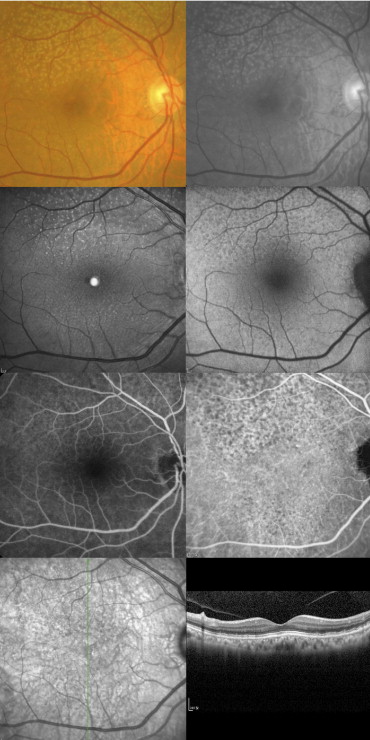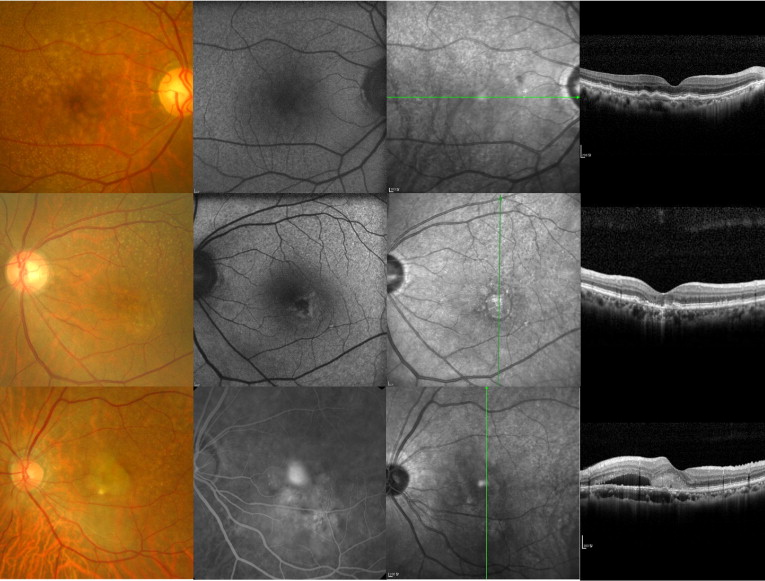Purpose
To clarify the clinical characteristics of reticular pseudodrusen in Korean patients.
Design
Retrospective, observational, consecutive case series.
Methods
A total of 255 eyes of 130 patients diagnosed with reticular pseudodrusen were evaluated. Reticular pseudodrusen were diagnosed by characteristic fundus findings using ophthalmoscopy, color fundus photography with blue-channel examination, near-infrared photography, red-free photography, autofluorescence imaging, fluorescein angiography, indocyanine green angiography, and spectral-domain optical coherence tomography. Age-related macular degeneration (AMD) was determined by the International Classification and Grading System.
Results
The mean age was 72.6 ± 9.0 years (range, 43 to 92 years). Most reticular pseudodrusen patients had bilateral disease (97.7%), with a female preponderance (86.2%). All 3 patients who showed unilateral reticular pseudodrusen had neovascular AMD in the eye with no reticular pseudodrusen. AMD was found in 183 eyes (71.8 %), among which early AMD was found in 115 eyes (45.1%), geographic atrophy was found in 41 eyes (16.1%), and neovascular AMD was found in 27 eyes (10.6%). The mean age of patients with AMD and with no AMD was 73.7 ± 9.2 years (range, 58 to 92 years) and 69.9 ± 11.7 years (range, 43 to 90 years), respectively, and there was a statistical difference between these 2 groups ( P < .05). Classic choroidal neovascularization was found in 13 eyes (48.1%), and occult choroidal neovascularization was found in 14 eyes (51.9%) in the neovascular AMD group.
Conclusions
Reticular pseudodrusen occurs in Koreans, and clinical manifestations of reticular pseudodrusen in Koreans did not differ significantly from those described in white persons. However, our study demonstrated a higher rate of bilaterality compared with those previously reported, and geographic atrophy was found to be associated more commonly with reticular pseudodrusen than with neovascular AMD. Ethnical differences may be associated with these findings, and further studies are required.
Reticular pseudodrusen were first described by Mimoun and associates in 1990 as “les pseudo-drusen visibles en lumière bleue” because of their enhanced visibility when they were viewed using blue light. Klein and associates included them as a type of soft drusen under the term reticular soft drusen in the Wisconsin Grading System; however, they were not recognized specifically in the International Classification and Grading System of Age related Macular Degeneration. Arnold and associates found no evidence of retinal drusen on the histopathologic study of 1 eye with clinical reticular pseudodrusen, and the term reticular pseudodrusen has been used in most studies based on this finding. The term subretinal drusenoid deposits recently was suggested by one group based on spectral-domain optical coherence tomography (SD OCT) and histologic findings. However, no standardized, generally accepted terminology and diagnostic criteria have been established for this disease. The previous term reticular pseudodrusen was used in the current study.
Ethnic differences in age-related macular degeneration (AMD) are known to exist. The prevalence of AMD varies considerably in different ethnic groups, and occurrence of AMD is less frequent in Asians than in white persons. The ratio of early AMD to late AMD is higher in white persons, whereas the ratio of neovascular AMD to geographic atrophy seems to be higher in Asians than in white persons. The prevalence of neovascular subtypes in late AMD are also different, such as polypoidal choroidal vasculopathy (PCV) being observed more frequently in Asians than in white persons. Considering these ethnic differences in AMD and the fact that no reference about reticular pseudodrusen in Asian populations could be found in a computerized searching using PubMed, we attempted to evaluate the nature of reticular pseudodrusen and the association of reticular pseudodrusen with AMD in Koreans. Multiple methods of imaging, including SD OCT, known to be necessary for accurate detection and diagnosis of reticular pseudodrusen lesions were used in this study.
Methods
We analyzed medical records and images of patients who previously were diagnosed with presumed reticular pseudodrusen at Samsung Medical Center between August 2009 and March 2011. Fundus examination was performed by slit-lamp examination with a wide-angle noncontact lens, indirect ophthalmoscopy, color fundus photography with blue-channel examination, near-infrared photography, red-free photography, autofluorescence imaging, fluorescein angiography (FA), indocyanine green angiography (ICGA), and SD OCT. Patients with a history of laser photocoagulation, central serous chorioretinopathy, rhegmatogenous or tractional retinal detachment, high myopia, or any degeneration were excluded.
The data obtained were analyzed using an independent t test. Statistical analyses were performed with SPSS software version 16.01 (SPSS, Inc, Chicago, Illinois, USA). A P value less than .05 was considered to be significant.
Image Acquisition
Fundus color photographs were obtained with a Topcon camera (IX50; Topcon, Paramus, New Jersey, USA) and were viewed in the Topcon ImageNet program (version 2.56; Topcon) for blue-channel examination, as indicated elsewhere. Red-free photography, near-infrared photography, autofluorescence imaging, SD OCT, FA, and ICGA were performed using a Spectralis HRA+OCT (version 1.5.2.0; Heidelberg Engineering, Heidelberg, Germany). Heidelberg software (Spectralis Viewing Module 5.3.2.0) was used for viewing of SD OCT images.
Age-Related Macular Degeneration
AMD was defined and classified by the International Classification and Grading System (ICGS) provided by the International ARM Epidemiological Study Group. AMD was divided into early AMD (early age-related maculopathy in the ICGS) and late AMD (late age-related maculopathy in the ICGS), and late AMD was subdivided into geographic atrophy (dry AMD in the ICGS) and neovascular AMD (wet AMD in the ICGS). In classification of AMD, reticular pseudodrusen were not considered as drusen, and multimodal imagings were used to differentiate reticular pseudodrusen from soft drusen. Choroidal neovascularization (CNV) of neovascular AMD was classified by the type of fluorescein leakage, based on guidelines from the Macular Photocoagulation Study group.
Reticular Pseudodrusen
Diagnosis of reticular pseudodrusen in this study was based on the appropriate findings: (1) detection of multiple yellowish white lesions with a reticular network in color photographs and blue-channel examinations; (2) light, interlacing network in red-free imaging; (3) hyporeflectant lesions with mild background hyperreflectance in near-infrared imaging; (4) hypofluorescent lesions against a background of mild hyperfluorescence in autofluorescence imaging; (5) subretinal deposits in SD OCT; and (6) hypofluorescent lesions in the mid or late phase of ICGA.
FA was used for diagnosis of CNV and for differential diagnosis with other lesions, such as cuticular drusen. ICGA was performed in the occult type of neovascular AMD to diagnose PCV and also used to detect reticular pseudodrusen lesions in a small number of patients. Images of each eye were assessed independently by 2 retinal specialists (M.Y.L. and D.-I.H.), and if both specialists agreed with the assessment, the eye was diagnosed as having reticular pseudodrusen.
Results
A total of 255 eyes of 130 patients were diagnosed as having reticular pseudodrusen without disagreement. All patients, except for 3, had bilateral reticular pseudodrusen; 3 patients had unilateral reticular pseudodrusen, and 2 patients had poorly visualized fundus because of media opacities in 1 eye. Overall, the rate of bilaterality was 97.7% (125/128). All 3 patients who showed unilateral reticular pseudodrusen (2.3%, 3/128) had neovascular AMD in the opposite eye with no reticular pseudodrusen. One hundred twelve patients (86.2%) were female, and 18 patients (13.8%) were male. The mean age was 72.6 ± 9.0 years and ranged from 43 to 92 years. All patients underwent fundus photography with blue-channel examination. Near-infrared imaging, SD OCT, autofluorescence imaging, and red-free imaging were performed in 82.8%, 81.6%, 79.6%, and 79.6% of patients, respectively. Of the total, 60.8% of patients underwent FA imaging and 25.9% underwent ICGA.
Reticular pseudodrusen were found as yellowish white spots with reticular pattern, as interconnecting networks with round or elongated oval lesions, or both in the color photographs. Reticular pseudodrusen had a more uniform size and shape than soft drusen and were identified easily with blue-channel examination, near-infrared photography, red-free photography, autofluorescence imaging, and ICGA. Reticular pseudodrusen were found most commonly between the upper edge of the fovea and the superior temporal vessels. On OCT, deposits were located between the sensory retina and retinal pigment epithelial layer, and the inner segment and outer segment junction frequently was raised or disturbed ( Figure 1 ) .

Reticular pseudodrusen were found with AMD in 183 eyes (71.8 %) and with no AMD in 72 eyes (28.2%). The mean age of patients with AMD and with no AMD was 73.7 ± 9.2 years (range, 58 to 92 years) and 69.9 ± 11.7 years (range, 43 to 90 years), and there was a statistical difference between these 2 groups ( P < .05). Pigmentary changes in the macula were observed in all reticular pseudodrusen eyes with no AMD except 1 eye (98.6%). Early AMD, geographic atrophy, and neovascular AMD were observed in 115 eyes (45.1%), 41 eyes (16.1%), 27 eyes (10.6%), respectively ( Figure 2 ) . The mean age of patients in the early AMD, geographic atrophy, and neovascular AMD groups was 72.3 ± 7.2 years (range, 60 to 84 years), 76.1 ± 7.8 years (range, 58 to 92 years), and 76.0 ± 6.0 years (range, 62 to 87 years), respectively ( Table 1 ). The mean age of patients in the geographic atrophy and neovascular AMD groups was older than that of the patients in the early AMD group ( P < .05); however, there were no statistical differences between patients in the geographic atrophy and neovascular AMD groups ( P = .33). Classic CNV was found in 13 eyes (48.1%) and occult CNV was found in 14 eyes (51.9%) in the neovascular AMD group.

Stay updated, free articles. Join our Telegram channel

Full access? Get Clinical Tree


